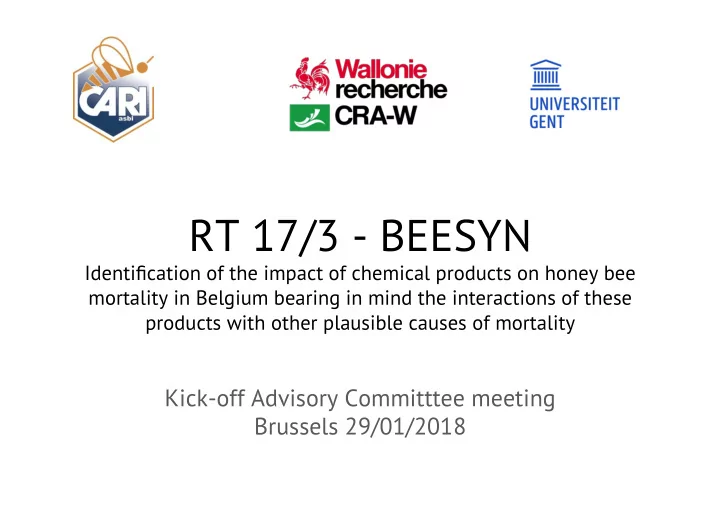

RT 17/3 - BEESYN Identification of the impact of chemical products on honey bee mortality in Belgium bearing in mind the interactions of these products with other plausible causes of mortality Kick-off Advisory Committtee meeting Brussels 29/01/2018
Objectives ▶ Describe the colonies chemical contamination levels and the origin of this contamination: ▶ By integrating data already available ▶ With new exposure data ▶ Determine to what extend such a contamination may determine the colony's fate when put in its context: ▶ its genetics ▶ pathogen/parasite load ▶ nutritional status ▶ climatic conditions ▶ land use around it ▶ beekeeping practices
Objectives ▶ Propose recommendations to mitigate the problem of colony mortality at several levels: ▶ Decision making (medicament and/or pesticide authorisation and use, bee health management) ▶ Scientific (further research questions) ▶ Practice (agricultural and beekeeping practice) ▶ Propose a tool box, including: ▶ indicators of bee health and pesticide exposure ▶ methods for pesticide surveillance using honey bees ▶ or cost-effective surveillance programmes for colony mortality
Context of the project ▶ A lot of studies (Belgium) on high level of bee colony losses → Fragmented picture of impact of stressors (pesticides…) ▶ Need to develop a holistic approach (MUST-B) ▶ Interaction between pesticides and other factors. ▶ Current information on the link between pesticides and bee mortality or morbidity ▶ BeeHappy → impact of Varroa and of some pesticides ▶ DEPAB → impact linked to fungicides and arable crops ▶ Expert groups work on ecotoxicology of bees
Partners ▶ CARI asbl - COORDINATOR ▶ Close relation with beekeepers – communication ▶ Pesticide regulatory expertise (relation with Bee Life) ▶ Bee ecotoxicology testing ▶ Varroa and honey flow monitoring ▶ Bee health and management projects
Partners ▶ Laboratory of Molecular Entomology and Bee Pathology, Department of Biochemistry and Microbiology, Ghent University ▶ Pathology of bees (BEEDOC, BeeDoctor, BeeClinic…) ▶ Close relation with beekeepers – communication ▶ Bee health and management projects
Partners ▶ Unité Protection des plantes et écotoxicologie, Centre wallon de Recherches agronomiques ▶ Tracing back the origin of contaminants ▶ Ecotoxicological tests on beneficial organisms and on honeybee ▶ Close relation with farmers ▶ Data science and statistical analyses
Multi-stressors and bee health Data generated or gathered within BeeSyn
Existing datasets
Existing data Project Owner DEPAB dataset CARI, CRA-W Epilobee dataset SPF, AFSCA,CODA COLOSS dataset CARI, UGent HealthyBee dataset AFSCA Varresist UGent BeeBestCheck + UGent, ULiege Water contamination SPF, Regions Air contamination CRA-W Other? -APIRISK (?) PC-Fruit (?)
W orking packages Ensures functioning Info gathering on and success colony health and + Admin stress factors + environment (2018) Test synergistic effects Integrate new + (2019-20 ) existing data and study the origin of contaminations (2018-19) Maximise visibility and impact
Planning 1st YEAR (2018) - Monitoring and data gathering 2nd YEAR (2019) - Data analyses and study of the effect of stressors combination in lab conditions (field conditions?) 3rd YEAR (2020) - Continue data analyses and study of the effect of stressors combination in field conditions (lab conditions?)
1st YEAR - Health monitoring and multi-stressors 100 apiaires (5 colonies/apiary) Flanders Wallonia Apiaries with problems 25 25 Healthy Apiaries 25 25 RESPONSIBLE UGent CARI 3 Visits in 2018: Spring (April/May), Summer (July/August), Autumn (September/ October) - Each visit: questionnaire + visit + sampling
Data Analysis (CRA-W) ▶ WP 2.1 : Collect and tidy up existing datasets ▶ > 1500 apiaries / 8 years ▶ Variable in terms of : ▶ Quality (online survey, availability of metadata, computer readable) ▶ Sample size ▶ Precision (i.e. localisation) Are the sources correct and complete ?
Data Analysis (CRA-W) ▶ WP 2.1 : Collect and tidy up existing datasets ▶ > 1500 apiaries / 8 years ▶ Variable in terms of : ▶ Available descriptive variables Are the sources correct and complete ? + For all datasets : Localisation - Landscape - Meteorological data
Data Analysis (CRA-W) ▶ WP 2.2 : Identification of areas with low/high winter mortality (early 2018) ▶ Aim : find contrasted beehive locations for the WP1 extended monitoring ▶ Use all > 1000 apiaries / 6 years already available ▶ Compute BLUPs from Mixed binomial models (van der Zee et al. (2014)
Data Analysis (CRA-W) Example of preliminary analysis of the 2016 CARI-FAB Coloss data only (255 locations)
1st YEAR - Health monitoring and multi-stressors
1st YEAR - Health monitoring and multi-stressors WP 1.2 - Multiresidue analysis (external) ▶ Public call for tenders to be launched (CARI) ▶ Multiresidue (possibly 2 lists) ▶ Fixed LODs (0.25 ppb) and LOQs (0.75 ppb) ▶ Priority list of a.i. searched
1st YEAR - Health monitoring and multi-stressors WP 1.2 - Pathogen prevalence analysis (UGent) ● Huge pathosphere Beesyn: viruses / nosema / Lotmaria
1st YEAR - Health monitoring and multi-stressors WP 1.2 - Transcriptomic analyses (UGent) 1. Screening for markers linked with Varroa tolerance 2. Stress indicator gene expression profiling
1st YEAR - Health monitoring and multi-stressors WP 1.2 - Melyssopalynological analysis Botanical origin of the beebread Nutritional potential of pollen Based on literature: Roulston and Cane 2000, Manning 2001, Somerville and Nicol 2002, Somerville 2005, Somerville and Nicol 2006, Di Pasquale et al. 2013
1st YEAR - Health monitoring and multi-stressors WP 1.2 - Antioxidant analysis total polyphenol and flavonoid content Objective - evaluate their antioxidant capacity
Synergy with other projects/Actions PolBees - CRA-W, CARI, ULB Ivan Meeus/Nicolas Vereecken - solitary / bumble bees Other: National - ??? International - ApisRAM
Meetings foreseen with the Advisory Committee Kick-off Mid-term Wrap-up (Jan 2018) (Sept 2019) (Dec 2020) Advisory COM
Interested in collaborating? Contact us: CARI - labo@cari.be (Marie Warnier) UGent - Lina.DeSmet@UGent.be (Lina de Smet) CRA-W - g.sanmartin@cra-wallonie.be (Gilles San Martin) Convention of collaboration could be signed and common work or communications could be envisaged.
Recommend
More recommend